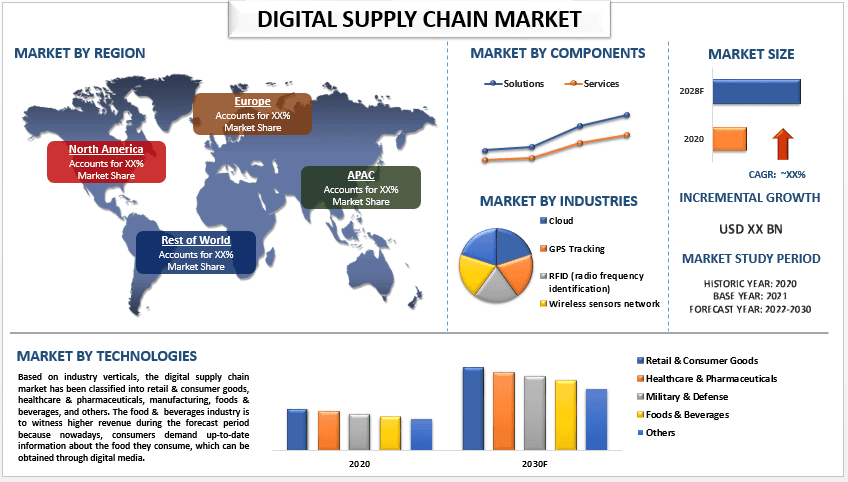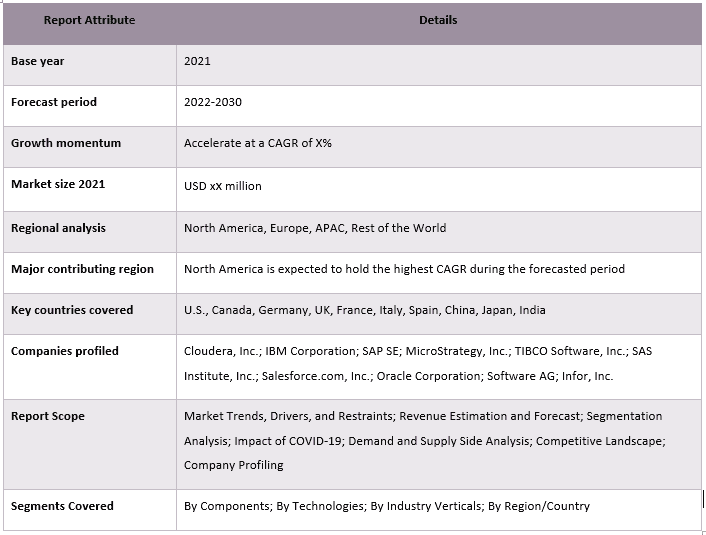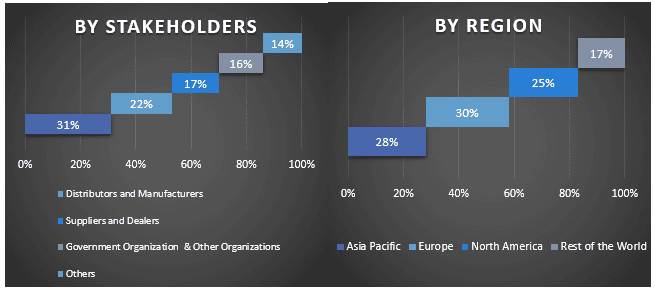Рынок цифровых цепочек поставок: текущий анализ и прогноз (2022-2028)
Акцент на компонентах (решениях и услугах); технологиях (IoT, облачные технологии, GPS-трекинг, RFID (радиочастотная идентификация), беспроводные сенсорные сети и другие); отраслевых вертикалях (розничная торговля и потребительские товары, здравоохранение и фармацевтика, производство, продукты питания и напитки, другие); и регионе/стране

Объем рынка цифровых цепей поставок был оценен в x млн долларов США в 2021 году и, как ожидается, будет расти в среднем на x% в период с 2022 по 2030 год.Благодаря растущему прогрессу в таких технологиях, как IoT, облачные сервисы, GPS и т.д. Цифровая цепь поставок – это цепь поставок, в которой используются цифровые технологии и анализ данных для принятия решений, повышения производительности и быстрого реагирования на изменяющиеся условия. Компьютеризированные цепи поставок используют информацию, предоставляемую каждым этапом сети инвентаризации, для эффективного планирования и динамичного реагирования при возникновении неожиданных задержек. Такие факторы, как повышенная персонализация, большая гибкость и улучшенное планирование, стимулируют спрос на этом рынке. В последние годы спрос на цифровые цепи поставок резко возрос, поскольку они облегчают оптимизированные транзакции, связывают различные производственные, дистрибьюторские и сервисные функции. Крупные компании на рынке предлагают приложения для анализа данных и прогнозного анализа больших данных с технологически продвинутыми функциями.
В число основных игроков, работающих на рынке, входят Cloudera, Inc.; IBM Corporation; SAP SE; MicroStrategy, Inc.; TIBCO Software, Inc.; SAS Institute, Inc.; Salesforce.com, Inc.; Oracle Corporation; Software AG; Infor, Inc.
Основные сведения, представленные в отчете
"Среди компонентов, сегмент решений будет свидетелем более высокого CAGR в течение прогнозируемого периода"
На основе компонентов рынок подразделяется на решения и услуги. В течение прогнозируемого периода ожидается, что сектор услуг будет демонстрировать самые высокие темпы роста, поскольку наглядность событий и цепи поставок помогает предприятиям в определении важнейших аспектов всей цепи поставок и управлении событиями в различных отделах. В последние несколько лет заметно возросло внедрение решений для управления цепями поставок, что привело к внедрению услуг, связанных с управлением цепями поставок, в различных отраслевых вертикалях
"Среди технологий, сегмент продуктов питания и напитков будет занимать значительную долю на рынке в 2021 году"
На основе технологий рынок делится на IoT, облачные технологии, GPS-слежение, RFID (радиочастотная идентификация). Среди них IoT будет занимать значительную долю на рынке в 2020 году. Это в основном связано с преимуществами, которые предлагает IoT, по сравнению с его аналогами, такими как повышение наглядности, улучшение обслуживания клиентов и отслеживание товаров в режиме реального времени.
"Северная Америка будет занимать значительную долю на рынке"
Ожидается, что Северная Америка будет расти с самым высоким CAGR в течение прогнозируемого периода. Это в основном связано с тем, что искусственный интеллект (AI), Интернет вещей (IoT), робототехника и автоматизация, автономные автомобили, дополненная и виртуальная реальность, цифровые двойники и сети 5G являются новыми технологиями в Северной Америке, которые стимулируют эту тенденцию. Кроме того, крупные игроки на рынке, такие как IBM Corporation, SAP SE и Salesforce.com, Inc., продолжают инвестировать в организацию различных чемпионатов для любителей Powersports. Например, IBM Corporation и CSCO прилагают много усилий для создания цифровых цепей поставок, которые являются более интеллектуальными и способными значительно повысить устойчивость и производительность.
Обзор отчета о рынке цифровых цепей поставок

Причины купить этот отчет:
- Исследование включает в себя анализ размеров рынка и прогнозирования, проверенный аутентифицированными ключевыми экспертами отрасли.
- В отчете представлен краткий обзор общих показателей отрасли с первого взгляда.
- Отчет охватывает углубленный анализ видных отраслевых аналогов с основным акцентом на ключевые финансовые показатели бизнеса, портфели продуктов, стратегии расширения и последние разработки.
- Подробное изучение драйверов, ограничений, ключевых тенденций и возможностей, преобладающих в отрасли.
- Исследование всесторонне охватывает рынок по различным сегментам.
- Глубокий анализ отрасли на региональном уровне.
Варианты настройки:
Глобальный рынок цифровых цепей поставок может быть дополнительно настроен в соответствии с требованиями или любым другим сегментом рынка. Кроме того, UMI понимает, что у вас могут быть свои собственные бизнес-потребности, поэтому не стесняйтесь обращаться к нам, чтобы получить отчет, который полностью соответствует вашим требованиям.
Содержание
Методология исследования для анализа рынка цифровых цепочек поставок (2022-2030 гг.)
Анализ исторического рынка, оценка текущего рынка и прогнозирование будущего рынка глобального рынка цифровых цепочек поставок были тремя основными шагами, предпринятыми для создания и анализа внедрения цифровых цепочек поставок в основных регионах мира. Было проведено тщательное вторичное исследование для сбора исторических данных о рынке и оценки текущего размера рынка. Во-вторых, для подтверждения этих выводов было принято во внимание множество результатов и предположений. Кроме того, были проведены исчерпывающие первичные интервью с отраслевыми экспертами по всей цепочке создания стоимости глобального рынка цифровых цепочек поставок. После предположений и подтверждения рыночных показателей посредством первичных интервью мы применили подход «сверху вниз / снизу вверх» для прогнозирования общего размера рынка. Затем были приняты методы декомпозиции рынка и триангуляции данных для оценки и анализа размера рынка сегментов и подсегментов, относящихся к отрасли. Подробная методология описана ниже:
Анализ исторического размера рынка
Шаг 1: Углубленное изучение вторичных источников:
Было проведено подробное вторичное исследование для получения исторических данных о размере рынка цифровых цепочек поставок из внутренних источников компаний, таких как годовые отчеты и финансовые отчеты, презентации о деятельности, пресс-релизы и т. д., и внешних источников, включая журналы, новости и статьи, правительственные публикации, публикации конкурентов, отраслевые отчеты, базы данных третьих сторон и другие надежные публикации.
Шаг 2: Сегментация рынка:
После получения исторических данных о размере рынка цифровых цепочек поставок мы провели подробный вторичный анализ для сбора исторических данных о рынке и доли для различных сегментов и подсегментов для основных регионов. Основные сегменты, включенные в отчет, включают компоненты, технологии и отраслевые вертикали. Был проведен дальнейший анализ на уровне стран для оценки общего внедрения моделей тестирования в этом регионе.
Шаг 3: Факторный анализ:
После получения исторических данных о размере рынка для различных сегментов и подсегментов мы провели подробный факторный анализ для оценки текущего размера рынка цифровых цепочек поставок. Кроме того, мы провели факторный анализ, используя зависимые и независимые переменные, такие как тип рельса и тип применения рынка цифровых цепочек поставок. Был проведен тщательный анализ сценариев спроса и предложения с учетом ведущих партнерств, слияний и поглощений, расширения бизнеса и запуска продуктов в секторе рынка цифровых цепочек поставок по всему миру.
Оценка и прогноз текущего размера рынка
Определение текущего размера рынка: На основе действенных выводов, полученных в результате вышеуказанных 3 шагов, мы определили текущий размер рынка, ключевых игроков на глобальном рынке цифровых цепочек поставок и доли рынка сегментов. Все необходимые процентные доли и разбивки рынка были определены с использованием вышеупомянутого вторичного подхода и проверены посредством первичных интервью.
Оценка и прогнозирование: Для оценки и прогнозирования рынка веса были присвоены различным факторам, включая движущие силы и тенденции, ограничения и возможности, доступные для заинтересованных сторон. После анализа этих факторов были применены соответствующие методы прогнозирования, т. е. подход «сверху вниз / снизу вверх», чтобы получить прогноз рынка на 2028 год для различных сегментов и подсегментов на основных рынках по всему миру. Методология исследования, принятая для оценки размера рынка, охватывает:
- Размер рынка отрасли с точки зрения выручки (в долларах США) и уровень внедрения рынка цифровых цепочек поставок на основных рынках внутри страны
- Все процентные доли, разделения и разбивки сегментов и подсегментов рынка
- Ключевые игроки на глобальном рынке цифровых цепочек поставок с точки зрения предлагаемых продуктов. Кроме того, стратегии роста, принятые этими игроками для конкуренции на быстрорастущем рынке
Подтверждение размера и доли рынка
Первичное исследование: Были проведены углубленные интервью с ключевыми лидерами мнений (KOL), включая руководителей высшего звена (CXO/VPs, руководители отдела продаж, руководители отдела маркетинга, руководители операционного отдела, региональные руководители, руководители стран и т. д.) в основных регионах. Затем были обобщены результаты первичных исследований и проведен статистический анализ для доказательства заявленной гипотезы. Вклад первичных исследований был объединен с вторичными результатами, превратив, таким образом, информацию в действенные выводы.
Разбивка первичных участников по различным регионам

Разработка рынка
Метод триангуляции данных был использован для завершения общей оценки рынка и получения точных статистических данных для каждого сегмента и подсегмента глобального рынка цифровых цепочек поставок. Данные были разделены на несколько сегментов и подсегментов после изучения различных параметров и тенденций в областях компонентов, технологий и отраслевых вертикалей на глобальном рынке цифровых цепочек поставок.
Основная цель исследования глобального рынка цифровых цепочек поставок
В исследовании были точно определены текущие и будущие рыночные тенденции глобального рынка цифровых цепочек поставок. Инвесторы могут получить стратегическое представление, чтобы основывать свое усмотрение для инвестиций на качественном и количественном анализе, проведенном в исследовании. Текущие и будущие рыночные тенденции определили общую привлекательность рынка на региональном уровне, предоставив промышленному участнику платформу для эксплуатации неиспользованного рынка, чтобы извлечь выгоду из преимущества первопроходца. Другие количественные цели исследований включают:
- Анализ текущего и прогнозируемого размера рынка рынка цифровых цепочек поставок в стоимостном выражении (в долларах США). Кроме того, анализ текущего и прогнозируемого размера рынка различных сегментов и подсегментов.
- Сегменты в исследовании включают области типа рельса и типа применения.
- Определение и анализ нормативно-правовой базы для индустрии цифровых цепочек поставок.
- Анализ цепочки создания стоимости с участием различных посредников, а также анализ поведения клиентов и конкурентов отрасли.
- Анализ текущего и прогнозируемого размера рынка рынка цифровых цепочек поставок для основного региона.
- Основные страны регионов, изученные в отчете, включают Азиатско-Тихоокеанский регион, Европу, Северную Америку и остальной мир.
- Профили компаний рынка цифровых цепочек поставок и стратегии роста, принятые участниками рынка для поддержания устойчивости на быстрорастущем рынке.
- Углубленный анализ отрасли на региональном уровне
Связанные Отчеты
Клиенты, купившие этот товар, также купили










